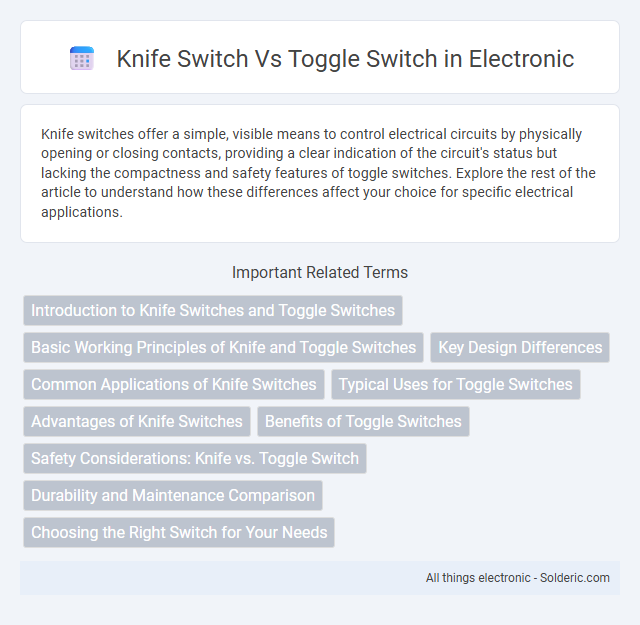Knife switches offer a simple, visible means to control electrical circuits by physically opening or closing contacts, providing a clear indication of the circuit's status but lacking the compactness and safety features of toggle switches. Explore the rest of the article to understand how these differences affect your choice for specific electrical applications.
Comparison Table
| Feature | Knife Switch | Toggle Switch |
|---|---|---|
| Design | Exposed lever and contact blade | Compact lever with internal contacts |
| Operation | Manual sliding action | Flipping action |
| Application | High power circuits and demonstration | Low to medium power electronics |
| Safety | Lower, exposed live parts | Higher, enclosed contacts |
| Durability | Less durable, prone to corrosion | More durable with sealed mechanism |
| Size | Larger size due to exposed parts | Smaller, compact size |
| Switching Speed | Slower manual switching | Faster, easier toggling |
| Cost | Generally lower cost | Moderate cost |
Introduction to Knife Switches and Toggle Switches
Knife switches consist of a metal lever that pivots to open or close an electrical circuit, typically used in low-voltage applications requiring visible and tactile confirmation of circuit status. Toggle switches feature a lever or handle that moves up and down or side to side to control electrical connections, offering compact design and convenience for frequent switching tasks. Both switch types serve distinct roles in electrical circuits, with knife switches favored for simplicity and visibility, while toggle switches are preferred for durability and ease of use in various devices.
Basic Working Principles of Knife and Toggle Switches
Knife switches operate by manually moving a metal lever (the "knife") into or out of contact with a metal slot to open or close an electrical circuit, relying on direct, visible mechanical action. Toggle switches function through a pivoting lever that moves between two or more positions to control circuit continuity, using internal spring mechanisms for snap-action switching. Both switches provide simple, reliable control of electrical currents but differ in design, safety, and typical applications.
Key Design Differences
Knife switches feature a simple, exposed lever that manually connects or disconnects a circuit by sliding a metal blade into a slot, offering clear visual confirmation of the switch position. Toggle switches use a pivoting lever or handle that moves between fixed positions within a housing, providing a more compact and enclosed design ideal for frequent operation. Your choice depends on the application requirements, durability, and safety considerations, with knife switches often used in high-current or industrial settings and toggle switches preferred for smaller electronic devices.
Common Applications of Knife Switches
Knife switches are commonly used in educational settings and industrial environments for controlling high-current circuits due to their simple, visible operation and reliable mechanical contacts. These switches are frequently applied in laboratory experiments, electrical panel maintenance, and heavy machinery isolation where manual actuation and clear disconnection are crucial. Your safety and ease of maintenance are enhanced by the straightforward design of knife switches, making them ideal for applications requiring a clear, physical indication of the circuit's open or closed state.
Typical Uses for Toggle Switches
Toggle switches are commonly used in industrial control panels, automotive applications, and household appliances due to their ease of operation and clear on/off positions. These switches provide reliable electrical connectivity for lighting systems, power tools, and machinery control. Their compact design and durability make them suitable for frequent switching in demanding environments.
Advantages of Knife Switches
Knife switches offer superior visibility of their open or closed state, enhancing operational safety by reducing accidental engagement. Their robust and straightforward mechanical design ensures high durability and reliable performance in high-current industrial applications. Maintenance is simplified due to the easily accessible contacts, making knife switches ideal for heavy-duty electrical circuits requiring frequent manual operation.
Benefits of Toggle Switches
Toggle switches offer significant advantages in terms of durability and ease of use compared to knife switches. Their compact design and enclosed mechanism reduce exposure to dust and electrical contact wear, enhancing safety and longevity. Toggle switches also provide quicker, more reliable switching action, making them ideal for modern electrical applications requiring frequent operation.
Safety Considerations: Knife vs. Toggle Switch
Knife switches offer visible on/off status and physical separation of contacts, enhancing safety in high-voltage or industrial environments but pose a higher risk of accidental contact and electrical arcs due to exposed metal parts. Toggle switches provide enclosed mechanisms that reduce exposure to live components, improving user safety in everyday applications and minimizing accidental activation. Proper use and maintenance of either switch type are critical to prevent electrical hazards and ensure optimal safety performance.
Durability and Maintenance Comparison
Knife switches are highly durable due to their simple mechanical design and robust metal construction, which facilitates easy maintenance by allowing quick visual inspection and manual cleaning. Toggle switches feature sealed housings that protect internal components from dust and moisture, reducing maintenance needs but potentially complicating repairs when issues arise. Your choice depends on prioritizing straightforward durability and ease of upkeep (knife switch) versus longevity in contaminated environments with less frequent maintenance (toggle switch).
Choosing the Right Switch for Your Needs
Knife switches offer simple, visible on/off control ideal for high-current circuits and easy manual operation, while toggle switches provide compact, versatile options suitable for low to medium current applications and frequent switching. When choosing the right switch for your needs, consider factors like current rating, space constraints, and operational environment to ensure safety and functionality. Your choice impacts reliability, ease of use, and the specific requirements of your electrical project.
Knife switch vs Toggle switch Infographic

 solderic.com
solderic.com